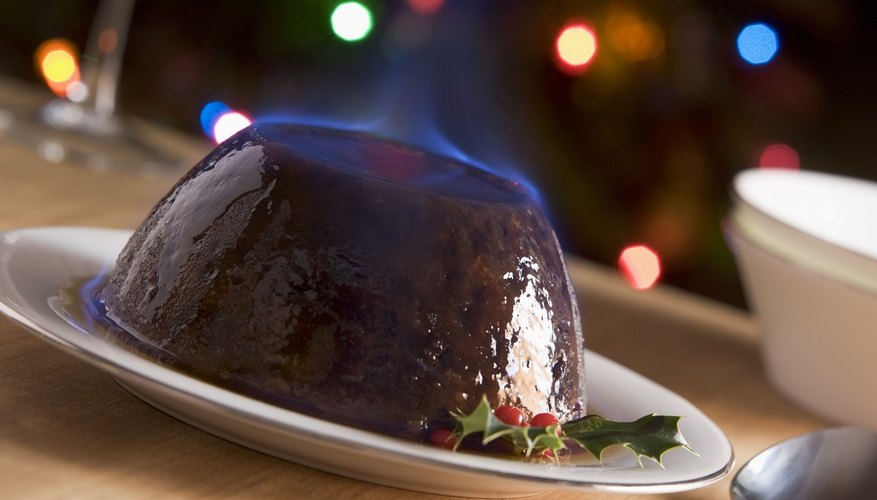Christmas pudding is a traditional English dish, which has spread to other English-speaking countries, such as Australia. This boiled or steamed pudding is also called plum pudding, plum duff, bag pudding or boiled pudding. Traditional Christmas puddings were often steamed in a square of fabric or bag. They were also sometimes wrapped in fabric after cooking and hung on a hook to dry out slightly. Some types of fabric are more suitable than others for making this food.
Muslin
Traditional pudding bags use a large square of muslin, a relatively light, plain-weave cotton fabric. Muslin is usually available only in white or natural cotton colour, and is thus devoid of dyes or other chemicals that might leach into the food. Some fabrics come with sizing or other chemicals applied, so wash the pudding cloth thoroughly in hot water before use to remove these substances and to allow for any natural shrinkage.
Cheesecloth
While most pudding recipes call for muslin, cheesecloth is also an acceptable fabric for wrapping puddings. This coarsely-woven cotton gauze resembles a net, and is often sold in green grocers. It may also be purchased from fabric stores, especially around Halloween, since cheesecloth is used to create a cobweb look for decorations. Since this fabric is so light, you might need to use many layers to provide enough strength to contain the pudding.
- While most pudding recipes call for muslin, cheesecloth is also an acceptable fabric for wrapping puddings.
- It may also be purchased from fabric stores, especially around Halloween, since cheesecloth is used to create a cobweb look for decorations.
Preparation
Pretreat new pudding cloths by soaking them in cold water overnight, then boiling for 20 minutes and rinsing. Prepare to wrap the pudding by placing it into boiling water for 1 minute. Wearing gloves, squeeze the extra water out of the cloth, spread it onto a table, and rub 30 to 40 g (1/4 to 1/3 cup) of flour in, using a circular motion. This flour later forms a “skin” on the outside of the pudding and keeps it from sticking to the cloth.
- Pretreat new pudding cloths by soaking them in cold water overnight, then boiling for 20 minutes and rinsing.
- Wearing gloves, squeeze the extra water out of the cloth, spread it onto a table, and rub 30 to 40 g (1/4 to 1/3 cup) of flour in, using a circular motion.
Techniques
Traditional Christmas puddings were boiled in the cloth, especially before the 19th century. Later puddings were sometimes poured into a greased mould, then steamed. Both types of Christmas pudding are often hung up in the pudding cloth to dry. According to Australian Women's Weekly, Christmas pudding can be made up to 3 months ahead of time. The pudding was stored in the cloth after drying. According to Gourmet Traveller, however, storing the pudding in fabric can encourage mould growth if your climate is warm and humid. Modern recipes usually recommend storing the pudding in the refrigerator or the freezer.
- Traditional Christmas puddings were boiled in the cloth, especially before the 19th century.
- The pudding was stored in the cloth after drying.
Considerations
The cloth for Christmas pudding is also sometimes called a pudding bag, but is rarely an actual sewn bag. Australian Women's Weekly recommends using a square of fabric about 60 cm (24 inches) on a side, as well as about 20 cm (8 inches) of kitchen string. The cloth is wrapped around the pudding and gathered at the top using the string, creating a baglike shape. Use excess string to hang the pudding.
- The cloth for Christmas pudding is also sometimes called a pudding bag, but is rarely an actual sewn bag.
